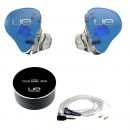 Guitar players with rack gear are constantly swapping rack modules, preamps, and pedals in and out of
Guitar players with rack gear are constantly swapping rack modules, preamps, and pedals in and out of
their racks as they try to create just the right tone that defines their signature sound. And once the rack gear is figured out, the patch connections can easily turn into a spaghetti tangle of mismatched cords of various lengths, making it extremely difficult to troubleshoot rack issues in a hurry (especially on a dimly lit stage).
Custom cable solutions are extremely popular with the rack crowd — not only do they result in better tone than tying up long cables, but they enable you to custom fit cables into your rack without any mess, making for a nice and tidy setup that is easy to troubleshoot and maintain.
George L’s has been making custom cable solutions for guitar players for over thirty-five years. Widely regarded for making some of the best sounding cables available, we decided to put their latest offering — the .155 Effects Kit, to the test. Armed with nothing more than some wire cutters and a small screwdriver, it was only a matter of minutes before we had replaced the cable mess behind one of our guitar racks with a beautiful custom solution that sounded fantastic.
The .155 Effects Kit includes ten feet of cable (.155mm is the cable diameter), ten straight ¼” plugs, ten right-angle plugs, and an assortment of colore
d stress-relief jackets. Although available in multiple color choices, we opted for the slightly more expensive blue cable kit — not just because we love blue, but because this package features gold-plated connectors instead of the standard nickel-plated plugs (gold is the best sounding, commonly-used material for conducting electrical signals).
Assembling cables was a straightforward affair, though not entirely easy until we got the hang of it. The process is as follows (for the straight plugs): cut the cable straight across, back out (loosen) the set screw in the plug far enough so that you can insert the cable into the end of the plug, push it very firmly so that it makes contact at the end, and then tighten the set screw enough so that it breaks through the outer sheath of the cable and makes contact with the wires inside.
The trick is twofold: pushing the cable in far enough to make contact with the tip, and then tightening the set screw enough to make contact with the sleeve. The instructions suggest turning the screw between one and two rotations, but we found that we had to tighten it significantly more to break through the heavy-duty sheath. A cable tester is useful for checking your cables, and we had to reassemble some of our cables a number of times until we got the hang of it.
Assembling the right-angle connectors was an easier affair, and no screwdriver was necessary. We just inserted the cable, bent the cable to exit the plug from the side, and then just tightened a thumbscrew at the rear of the plug to make the wire connection.
Color-coded stress-relief covers were provided. On the straight plugs, remember to slide the covers onto the cut wire first, before you attach the jacks, or else you’ll be reassembling that cable, too! (Yes, every hard lesson to learn was, in fact, learned the hard way while rewiring our rack.) The right-angle covers slide on after you’ve assembled the cables.
The end result? The cables sound great, and our rack is significantly more impressive when we look at it from the rear (not to mention easier to figure out the signal paths visually). We still have to replace a few cables with additional parts — ten straight- and right-angle plugs may not work best depending on your particular rack situation, and in our case we could use a few more straight connectors.
Reviewing the audio quality of cables in a scientific manner is a challenging process to say the least, and it’s impossible to accurately pick one wire as sounding truly better than the next. But suffice to say that premium quality cables in general (like these) sound significantly better than cheap store-brand cables.
Our George L’s sounded quiet and full-spectrum with regard to our tone — just what our thousands of dollars worth of rack gear and tube amps demanded. Our rack couldn’t be happier.
The .155 Effects Kit with gold plugs sells direct from the George L’s website for $114, or the standard kit can be purchased for only $99. You can also purchase an assortment of cables and connectors a la carte, including some pre-manufactured instrument cables featuring George L’s premium cables and connectors.
Contact Information
George L’s
www.georgels.com
















